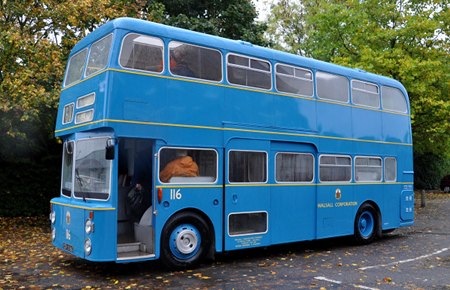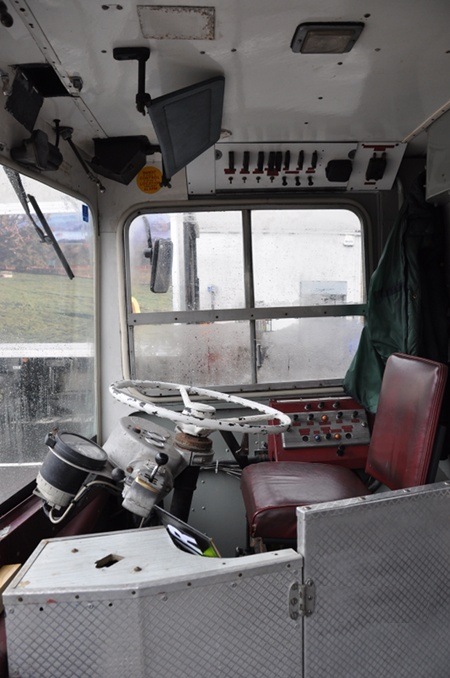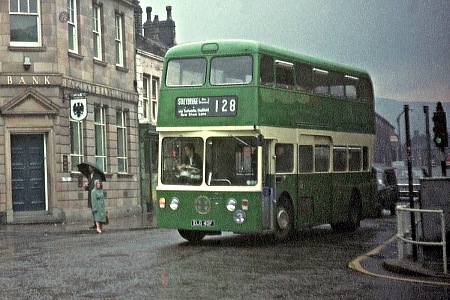Stalybridge, Hyde, Mossley and Dukinfield
1968
Daimler Fleetline CRG6LX
Northern Counties H41/27D
It’s August 1968 and a wet day in Glossop. One of SHMD Board’s recently delivered Walsall inspired short dual entrance Fleetlines is about to turn at the traffic lights outside the Norfolk Arms on a 127 to Stalybridge. North Western’s Glossop Depot is further up the road behind the Fleetline. These buses looked quite elegant in this livery but were totally unsuited to the SELNEC orange and white applied after the PTE takeover. Note the Rotavent ventilators in the side windows in lieu of sliding top lights, these were very much in vogue at the time.
Photograph and Copy contributed by Ian Wild
A full list of Daimler codes can be seen here.
19/10/12 – 06:34
The introduction of the V shaped lower deck windscreen changed a plain and fairly dull NCME design into something much more attractive compared to the full sized vehicle of previous deliveries.
Why SHMD went to a smaller vehicle when every operator around it – even Stockport – had gone for something bigger is a question I can’t answer.
The narrow front door wasn’t particularly well liked but the vehicles performed reasonably well in service and I agree, the SELNEC scheme ruined the overall look.
Phil Blinkhorn
19/10/12 – 11:12
It’s an odd combination, with folding front door and a sliding one amidships. I have a bought view of a “C” suffix unit from this fleet, and it has only a cream stripe below the upper windows – above the indicator display. This looks far better.
Pete Davies
19/10/12 – 12:44
This was a strange vehicle design contrived by the innovative Edgeley Cox at Walsall where a large fleet of this type was operated. Was there some relationship between the managements at SHMD and Walsall to cause SHMD to choose these vehicles? I have always rationalised the concept in my mind on the basis that the narrow front door would be used as the entrance if the bus was working one man but could be kept closed and the centre door used conventionally for entry and exit if a conductor was on board just like a normal forward entrance front engined decker. Anybody know if this is right?
It is interesting that SHMD also had a history of innovation with the centre entrance Daimlers and of course the solitary double deck Atkinson in the mid-fifties. I understand these were inspired by a GM who had been at Blackpool, the spiritual home of centre entrance double deckers.
All this adds up to show what powers the municipal GM’s seemed to have in those glory days in including individual quirks into new vehicle specifications.
Philip Halstead
19/10/12 – 14:43
Philip is correct about the idea behind the door usage.
I’m not aware of any direct link between SHMD and Walsall and it would be interesting to see the minutes relating to the decision to purchase the vehicles. Presumably these are archived by Tameside MBC if any one has access.
Phil Blinkhorn
19/10/12 – 16:48
Were Walsall heavily into short Fleetlines? I remember seeing one/some with no front cantilever. I can’t remember how/where the driver sat!
I am often in these congested days puzzled as to why passenger numbers fall and bus sizes rise….
Joe
19/10/12 – 17:34
Walsall had 99 short Fleetlines. The first was only 25′ 7″ with no front overhang and an entrance behind the driver’s position pretty much the layout adopted by forward entrance front engined vehicles.
The next 29 were of the same layout but were 27′ 6″ with a front overhang. All of the above had wrap around windscreens on both decks.
The next 69 were 28′ 6″ long and were identical in looks to the SHMD vehicles. A comprehensive set of photos can be found by searching Walsall Fleetlines on Flickr. The last supposed Fleetline, actually the unique Daimler CRC6-36, went to to the other extreme with a 36′ length and two staircases.
Phil Blinkhorn
20/10/12 – 06:21
Thanks Phil for confirming my theory on the entrance/exit concept. I always feel that Edgeley Cox was to the bus world what Oliver Bullied was to railways. Both were great innovators and must have been strong personalities in that they got their employers to adopt large numbers of very unusual vehicles (locos in Bullied’s case) where a more standard solution would have almost certainly made more commercial sense. Sorry to digress into the world of flanged wheels on this site but the parallel has always struck me.
Philip Halstead
20/10/12 – 15:03


Since the current posting has mentioned the Walsall short Fleetlines buses I thought you may like to see a couple of shots taken of the preserved Walsall vehicle, which is part of the Wythall collection it was used in 2010 to celebrate the end of trolleybuses in Walsall by following most of their former routes.
Ken Jones
20/11/12 – 05:28
I’m not “into” buses but came across the article on S.H.M.D. Fleetlines, the last six of which seemed to be used a lot on 2-man services like the 125 in the ’70s. Were these buses sent to Glossop after the P.T.E. absorbed the North-Western operation there, to replace the Renowns on conductor-operated routes, while the earlier,’conventional’, 56XX Fleetlines were cascaded out of the area to depots like Leigh-perhaps to replace A.E.C.s there in a similar role? Does anyone know if the ‘preserved’ S.H.M.D. Fleetline that was being kept at Mossley (I think) still exists?
John Hardman
20/11/12 – 11:33
On the last point, I can confirm that Fleetline number 28 is still there, along with PD2 number 5.
David Beilby

Leave a Reply